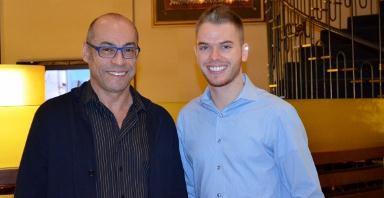With WorldPride just over a year away, some critics are worried Toronto isn’t ready for the international celebration.
There have been some major missteps, including WorldPride’s release of its theme song before securing the rights, but co-chairs Sean Hillier and Francisco Alvarez are confident the festival will come together in time for June 20, 2014.
In 2012, Pride Toronto (PT) received the least amount of funding of the city’s 10 major cultural organizations, a total of $123,807. As a result, WorldPride issued a request for submissions from firms to design a pro-bono marketing campaign.
“We need to be present in different forms at all the Prides around the world and other various LGBT events in the next year,” Alvarez says.
The organization hopes to unveil the campaign by May.
Despite the city’s limited Pride funding, Alvarez says the municipal and provincial governments have been supportive on the tourism side. The president of Tourism Toronto accompanied the PT contingent to WorldPride London last year, and Alvarez says WorldPride board members meet with Tourism Toronto on a weekly basis.
“We’re putting together a big grant application for the remaining piece, which is all about having a presence internationally,” Alvarez says.
The provincial and municipal governments have identified international markets as key to the success of WP, Alvarez says.
An international human rights conference will be part of WorldPride’s programming. Citizens from countries notorious for blemished human rights records, including Uganda and Russia, will attend using scholarship funds.
“We absolutely must make WorldPride an international event that is really meaningful so that we can learn from the experiences of people all around the world and likewise can share with them and hopefully support them in their efforts for human rights,” Alvarez says.
Corporate sponsorship is essential to any large festival despite objections from some detractors, who say sponsorship cheapens the celebrations.
With 300 performers and seven stages requiring lighting and sound technicians, Alvarez says the only alternative to corporate sponsorship would be to charge admission.
“It’s not really feasible for us. We’re continuing with the model that we have,” he says.
For WorldPride, PT must raise $1.5 million more than it would in an average year. The only way to achieve that target is to attract corporate dollars, Alvarez says.
He says WorldPride is not ready to release the names of the sponsors of the 2014 event.
In the midst of the fervent planning that accompanies such a large-scale endeavour, some critics say Pride is in danger of losing its grassroots focus, a criticism that Hillier, who identifies as two-spirit, doesn’t take lightly.
“Pride represents a diversity of different interests. The people and the board are becoming more and more diverse every year, and right now we have a number of different representatives from a number of different backgrounds,” Hillier says. “The goal of WP is to make this an international festival. We want to ensure that it is representative from around the world.”
The acronym used to describe the queer community keeps acquiring letters, Alvarez notes, adding that Pride should be welcoming to every facet of that community.
“Our fundamental belief is that even within those communities, there’s something that unites us. We are not going to be pleasing to the extreme, radical members of any one of those communities. We also have to be palatable to government and corporate sponsors; it’s definitely a compromise,” he says. “The whole problem we’ve had over the past couple of years with funding at the city level is simply because we defend the right of every group to be in Pride if they are queer, and we absolutely hold to that.”


 Why you can trust Xtra
Why you can trust Xtra


